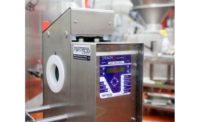Company: Fortress Technology
Website: www.fortresstechnology.com
Equipment Snapshot: Fortress Technology has designed a multi-aperture, multi-lane metal detector range, assisting food manufacturers to reduce factory footprint, investment and on-going operating costs. Already installed in two, four and five lane configurations by several global food factories, with just one system to maintain and manage, the multi-aperture unit can improve total cost of ownership (TCO) by over 65 precent longer term.
Featuring a single metal detector mounted across multiple food packing and processing conveyor lines, the Fortress unit is uniquely divided into individual apertures, setting a new industry standard for performance. Since each aperture is smaller, the machine has the ability to detect metal fragments as small as 0.8 mm ferrous, 0.8 mm non-ferrous and 1.2 mm stainless steel, regardless of the number of lanes travelling through the unit. In addition, the smaller aperture copes better with orientation and product effect.
Consolidating this multi-aperture technology into one unit spanning multiple lanes, opposed to individual metal detectors, cuts the equipment footprint by over 50 percent and optimizes factory floor space. The unit also sharpens operational efficiencies, reducing initial investment costs for food processors and packers by up to 40 percent compared to purchasing individual metal detectors for each line. With just one system to maintain and manage, a five lane multi-aperture unit can improve total cost of ownership (TCO) by over 65 percent longer term, considering reduced maintenance and parts requirements.
Many of today’s food factories are working around legacy equipment and have severe spatial limitations. This means compact design is increasingly a prime consideration.
Until now, high-speed packing operations had limited multi-lane contaminant detection options. They could either channel multiple lanes through a much larger single metal detector aperture. The clear drawback here is that the larger aperture size sacrifices valuable levels of sensitivity. This is because the larger aperture is looking for metal contaminants in multiple products and dealing with multiple signals, making it less sensitive.
In addition, any reject system will remove an entire line of product across all the lanes being checked, resulting in higher volumes of false rejects, creating unnecessary waste. In comparison, the Fortress multi-aperture system only inspects and rejects contaminated products from the individual conveyor, which in a five-lane system can reduce false product rejects by 400 percent.
The other alternative - inserting individual metal detectors between each conveyor - is a costlier investment option, both at the initial outlay and to maintain for the lifetime of each machine. It also doubles the system’s footprint, even when the metal detectors are staggered.
A single control panel manages all lanes, streamlining operator access and enabling production managers to select and view data by individual lane, as well as analyze comparative lane data side-by-side. To increase production efficiency, each lane is programmed to run independently from each other. So, if one lane stops working or requires maintenance, the remaining continue to run as normal, therefore minimizing business interruption.
On five conveyors, food factories can save up to 50 percent of the space required by individual metal detectors, around 17 percent of the installation cost, and up to 65 percent of the total cost of ownership.
One of Europe’s largest bakeries was the most recent customer to install a Fortress multi-aperture unit. Rather than having one metal detector head spanning two lanes, Borgesius wanted to be able to measure if there was a metal contaminant issue in the individual line. Logistically, having two metal detectors would not have been feasible, as it would have prohibited the bakery from running two conveyors so closely together.
Metal detection sensitivity was also something the bakery wasn’t prepared to compromise on. They requested a minimum of 1.8 mm ferrous, 2.8 mm non-ferrous and 4.0 mm stainless steel, which the individual Fortress apertures easily accomplish. Because each aperture on this unit measures just 200mm in height and 450mm wide, the bread loaves pass right through the centre point of the metal detector. This means the inspection system can cope better with orientation and product effect.
The ability to separate rejected product was a decisive factor for the factory. If there’s an issue on one line, the production team can now quickly identify and address it, which helps to reduce product waste and false rejects.
While several food inspection companies have attempted to design a multi-lane system of this kind, Fortress Technology has succeeded first. By challenging the status quo, the company has generated a truly innovative system that marks the end of food factories compromising on any performance criteria, including TCO, space and metal detection sensitivity.



